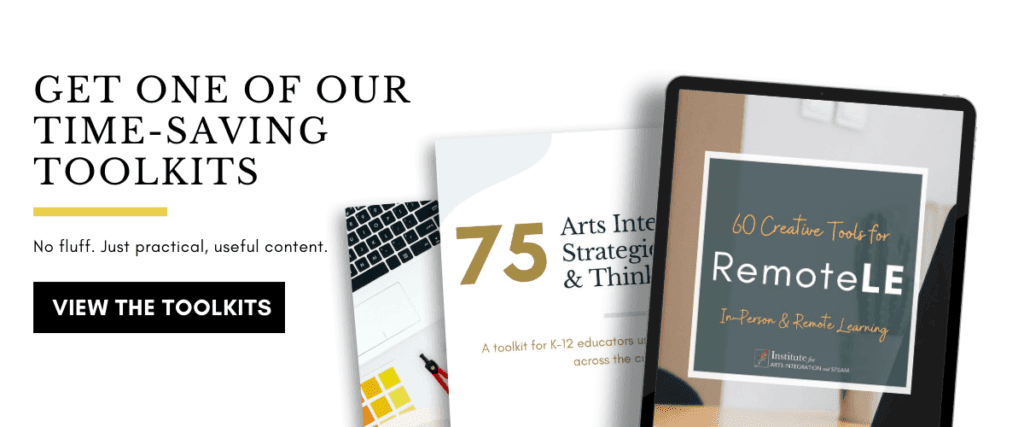Differentiated Collaboration for Arts Integration
4 Min Read • Differentiation
We’ve all been there… looking for something to increase student engagement or deepen student learning. Many teachers have heard about and are interested in the idea of arts integrated lessons and projects for the classroom. But, I have found that many teachers don’t know where to begin in terms of collaborating with their colleagues regarding arts integration. What does this collaboration look like? As an arts teacher, you might be nervous or uncomfortable approaching the non-arts colleagues because they haven’t established a relationship with them. This can also go the other way – the non-arts teacher might not be confident in his/her “arts skills” and not sure where to begin.
Differentiated Collaboration is… Differentiated.
In my experience, there is no right or wrong way… as long as you are both open to new ideas and collaborating! And just as no two people are alike, collaboration amongst teachers doesn’t always look the same. I like to call this differentiated collaboration. The term differentiation is readily used in classrooms around the world, but typically only associated with students and their needs. Well, teachers are no different! Every time I work with a teacher on developing and/or co-teaching an arts integration lesson, it “looks” different for a number of reasons.
My relationship with each teacher is different.
Honestly speaking, some relationships are better than others; but regardless, we are two people with different personalities trying to work together for a common goal. And, this never “looks” the same!
Each non-arts teacher brings a different level of comfort in working with the arts.
Do they connect more with visual art, music, dance, or theater? Or, they may not think that they are comfortable with any art form because they don’t view themselves as “creative.”
Each teacher is in a different place with how comfortable they are with arts integration.
Are they more on the arts enhancement side or arts integration side of the continuum? For more information on this, check out EducationCloset’s video discussing the Arts Integration Continuum.
Location & Time
Are we located in the same building? Do we have any common “free” time in our schedules? If the answer is no to both of these, then digital is the way to go! Google Docs, text, email, phone, or virtual call will solve that problem very easily!
Keeping in mind that no two collaborative efforts for an arts integration lesson will “look” the same, I’ve created a sample step-by-step guide that is a great place to start.
Steps to the Collaboration Process
Step 1
Quick conversation in passing, in the hall between classes, at the mailboxes, by the copy machine, or via text/email. Non-arts content teacher may say, “Hey, I have a unit coming up on Human Rights and thought it would work well for an arts integrated lesson. Do you have any ideas?” Arts teacher responds, “Yes! That sounds great! Let me think about it and get back to you! Do you know what discipline you want to integrate? Visual arts, music, theatre or dance?”
Step 2
Arts teacher completes some research on the topic and brainstorms potential lesson ideas.
Step 3
Arts teacher emails/texts the non-arts teacher to set up a time for a quick conversation. Arts teacher sends the non-arts content teacher the Pre-Planning Guide to complete before their meeting.
Step 4
The two teachers bring their completed Pre-Planning Guides and meet to finalize the lesson idea. The arts teacher also brings the Collaborative Planning Guide to help guide their conversation. They also make sure to discuss the non-arts and arts standards that will be integrated throughout the lesson. The arts teacher sends the non-arts teacher a Google Doc of the arts integration lesson plan template that they can start working on together.
Step 5
Teachers collaboratively create the lesson plan via Google Docs. Teachers also have brief conversations via email, text, and/or face-to-face as needed. This step can take as much time as needed as both teachers listen and communicate how to best align the selected standards.
Step 6
Once the lesson plan is well on its way, the teachers meet briefly to discuss the assessments that will be used (diagnostic, formative, and summative).
Step 7
One of the teachers shares a Google Doc that they can use to collaboratively draft the assessment pieces that they will need. Both teachers discuss the assessment pieces (rubrics, checklists, continuum, etc.) they will use. Reminder: include the standards that are being assessed on each assessment piece!
Step 8
Co-teach the arts integrated lesson as time permits. If the teachers cannot be together for all classes, think about having the teachers together for one period to roll out the lesson. Remember that it is the selected standards that are being taught, so focus on those aligned art and non-art standards.
Step 9
Complete the lesson reflection questions as soon as the lesson has been delivered, as this will help you to think about how the arts integrated lesson went, as well as plan for future iterations of this lesson. Ideally, both teachers should complete this together.
Remember – think differentiated collaboration. You may jump from Step 1 to Step 3 to Step 5 and that’s okay! What matters most is how you begin the journey and what your students gain at the end of it! And, don’t forget to celebrate your success in collaborating, as it will lead to your next collaboration for arts integration!




